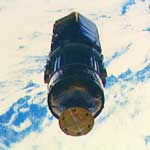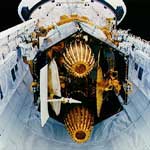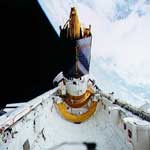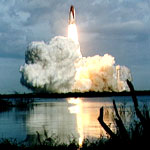
History of the Tracking and Data Relay Satellite System
Past launches of TDRS spacecraft
BY STEPHEN CLARK AND JUSTIN RAY
SPACEFLIGHT NOW
Posted: June 26, 2000

| TDRS-A |
Challenger • STS-6 |
Launch date: April 4, 1983
Launch site: LC-39A, Kennedy Space Center, Fla.

| |

TDRS-A artist's concept.
|
After the days of ground stations during the Mercury and Gemini programs,
NASA was ready to do away with that concept, instead opting for the safer idea of near-continuous communications and telemetry coverage with manned spacecraft. NASA called the program the Tracking and Data Relay Satellite System (TDRSS). The first was TDRS-A.
TDRS-A was launched on space shuttle Challenger's maiden flight. After deployment, the satellite was to be boosted to Geostationary Orbit (GEO) using a Boeing-built Inertial Upper Stage (IUS). However, a malfunction of the IUS booster left the craft in a wrong orbit. On-board thrusters were used to place the satellite into its proper orbit 22,300 miles above Earth. This extra use of propellant reduced the planned lifetime of TDRS-1, which was given the number designation after becoming operational.
Other payloads on STS-6 were the Continuous Flow Electrophoresis System
(CFES), the Monodisperse Latex Reactor (MLR), the Radiation Monitoring Experiment (RME), and the Night/Day Optical Survey of Lightning (NOSL). Also included were three small self-contained payloads. The missions also included the first spacewalk of the space shuttle program, and the first light-weight external tank.
The four-man flight crew was led by commander Paul Weitz, with pilot Karol Bobko and mission specialists Donald Peterson and Story Musgrave.
Current status: After years of operation, NASA removed TDRS-1 from full-time service at its 49 degrees West longitude slot due to its degraded health. Today the craft provides part-time coverage of the Antarctic region in support of the National Science Foundation. Its orbit is currently inclined 10.5 degrees.
|
 |
| TDRS-B |
Challenger • STS-51L |
Launch date: January 28, 1986
Launch site: LC-39B, Kennedy Space Center, Fla.

| |

Shuttle explosion.
|
After the launch of the first TDRSS spacecraft, NASA was ready to launch the
second satellite of the constellation, TDRS-B. This satellite would bring the system up to full operational capability.
That was, however, not to be. Tragically, just 73 seconds after liftoff,
Challenger was enveloped in a fireball that claimed both crew and vehicle. The accident was blamed on an O-ring failure in the right-hand Solid Rocket Booster (SRB). Extremely cold conditions were named as a contributing cause.
Besides the deployment of TDRS-B, the mission was to have temporarily
deployed an astronomy satellite. It would have been captured after two days in space to be brought home. Observations of Halley's Comet and classes being taught from space were also on the flight plan.
The seven-person flight crew was led by commander Francis Scobee, with pilot Michael Smith, mission specialists Judith Resnik, Ellison Onizuka and Ron McNair and payload specialists Gregory Jarvis and Christa McAuliffe.
|
 |
| TDRS-C |
Discovery • STS-26 |
Launch date: September 29, 1988
Launch site: LC-39B, Kennedy Space Center, Fla.

| |

TDRS-C leaves shuttle.
|
With the capabilities of TDRS-1 degraded, NASA felt it urgent to launch
TDRS-C, to insure communications with the shuttle and other satellites in Low Earth Orbit (LEO). The ground stations had already been shutdown.
Shuttle Discovery's STS-26 mission marked America's return-to-space after the Challenger disaster. Spacecraft deployment occurred just hours after launch. After being released, the Boeing-built Inertial Upper Stage (IUS) placed the craft into a near-perfect orbit. The craft would be renamed TDRS-3.
Other payloads on the STS-26 flight were the Physical Vapor Transport of Organic Solids (PVTOS), an experiment analyzing crystal growth, an experiment studying infrared communications, and an experiment to find out how red blood cells react to microgravity.
Veteran shuttle commander Rick Hauck led the astronaut crew, with pilot Dick Covey and mission specialists John Lounge, George Nelson and David Hilmers.
Current status: TDRS-3 is still operating at 275 degrees West longitude, making it the TDRS Exclusion satellite. Its orbit is inclined 4.8 degrees.
|
 |
| TDRS-D |
Discovery • STS-29 |
Launch date: March 13, 1989
Launch site: LC-39B, Kennedy Space Center, Fla.

| |

TDRS-D in payload bay.
|
With the launch of TDRS-D, NASA would finally have full operational
capability with the TDRSS system.
The satellite was deployed from the orbiter's payload bay just hours after reaching space. Following the two burns of the Inertial Upper Stage, the new TDRS-4 was placed into its proper Geostationary Orbit 22,300 miles high.
Other payloads included the Orbiter Experiments Autonomous Supporting Instrumentation System-1 (OASIS-1), a cooling system designed for a spin-off of the International Space Station (ISS), a crystal growth experiment, and a hand-held IMAX camera.
The STS-29 crew was commanded by Mike Coats, with pilot John Blaha and mission specialists Jim Bagian, Jim Buchli and Bob Springer.
Current status: TDRS-4 is still operating at 41 degrees West longitude, serving as the TDRS East satellite. Its orbit is inclined 2.4 degrees.
|
 |
| TDRS-E |
Atlantis • STS-43 |
Launch date: August 2, 1991
Launch site: LC-39A, Kennedy Space Center, Fla.

| |

TDRS-E set for deploy.
|
When the TDRSS system was laid out, two satellites were supposed to be
working at one time, and there was to be one spare. TDRS-E would be that spare.
After launch, the satellite was ejected from the shuttle's
cargo bay that night. After successful IUS burns, the satellite was released into a nominal orbit. It was renamed TDRS-5.
Other payloads on Atlantis were a cooling system designed for a spin-off of
the International Space Station (ISS), a solar observation instrument, and the Ultraviolet Plume Imager (UVPI).
Commander John Blaha led the STS-43 flight crew with pilot Mike Baker and mission specialists Shannon Lucid, Jim Adamson and David Low.
Current status: TDRS-5 is still operating at 174 degrees West longitude, serving as the TDRS West satellite. Its orbit is inclined 1.5 degrees.
|
 |
| TDRS-F |
Endeavour • STS-54 |
Launch date: January 13, 1993
Launch site: LC-39B, Kennedy Space Center, Fla.

| |

STS-54 launch.
|
With the growing demand for live communications with orbiting satellites,
TDRS-6 was rushed into service.
The primary payload of STS-54, TDRS-F, was deployed on day one of the
mission. The Boeing-built Inertial Upper Stage successfully completed two burns to place the TDRS-6 satellite into its proper orbit.
Other payloads in Endeavour's payload bay and mid-deck were a instrument to
collect data on X-ray sources in deep space, an experiment to study plant growth, and an experiment to study how the skeletal system adapts to the microgravity environment. A spacewalk was performed by astronauts Mario Runco and Greg Harbaugh to expand NASA's knowledge of working in space.
The astronauts were commander John Casper, pilot Don McMonagle and mission specialists Runco, Harbaugh and Susan Helms.
Current status: TDRS-6 is still operating at 47 degrees West longitude, serving as the TDRS Spare satellite. Its orbit is inclined 0.7 degrees.
|
 |
| TDRS-G |
Discovery • STS-70 |
Launch date: July 13, 1995
Launch site: LC-39B, Kennedy Space Center, Fla.

| |

Against blackness of space.
|
The TDRS-G satellite, ordered to replace the one lost aboard Challenger, was the last TDRSS satellite built by TRW and launched by the space shuttle. The next three will be built by Hughes Space and Communications and will be launched using unmanned Lockheed Martin Atlas 2A rockets.
Around six hours after launch, TDRS-G was released out of Discovery's payload bay. Two burns of the Inertial Upper Stage placed the craft into a good orbit 22,300 miles above Earth. The craft was renamed TDRS-7.
Other payloads carried into orbit by Discovery were an experiment to study
crystal growth, an experiment to study the effects of long-term weightlessness, and the Shuttle Amateur Radio Experiment-II (SAREX-II)
The STS-70 crew was led by commander Tom Henricks, pilot Kevin Kregel and mission specialists Nancy Currie, Don Thomas and Mary Ellen Weber.
Current status: TDRS-7 is still operating at 171 degrees West longitude. Its orbit is inclined 3.2 degrees.
|
 |

|
 |
 |
 |
Next launch
Vehicle: Atlas 2A (AC-139)
Payload: NASA's TDRS-H
Launch date: June 30, 2000
Launch window: 1238-1318 GMT (8:38-9:18 a.m. EDT)
Launch site: SLC-36A, Cape Canaveral, Fla.

Pre-launch briefing
Atlas 2A vehicle data - Overview of the rocket that will launch TDRS-H into space.

TDRS-H - Description of the satellite to be launched on AC-139.

Launch timeline - Chart with times and descriptions of events to occur during the launch.

Launch windows - Available windows for possible future launch dates of AC-139.


Video vault
 Animation shows NASA's Tracking and Data Relay Satellite-H working in geostationary orbit above Earth.
Animation shows NASA's Tracking and Data Relay Satellite-H working in geostationary orbit above Earth.
PLAY (285k, 24sec QuickTime file)

 Satellite builder Hughes tests the 15-foot diameter graphite shaped springback reflector antennas on TDRS-H.
Satellite builder Hughes tests the 15-foot diameter graphite shaped springback reflector antennas on TDRS-H.
PLAY (169k, 12sec QuickTime file)

Download QuickTime 4 software to view this file.

Flight profile
 Track the major launch events for the Atlas 2A rocket carrying the TDRS-H satellite on Spaceflight Now's interactive flight profile page (requires JavaScript). Track the major launch events for the Atlas 2A rocket carrying the TDRS-H satellite on Spaceflight Now's interactive flight profile page (requires JavaScript).





|

